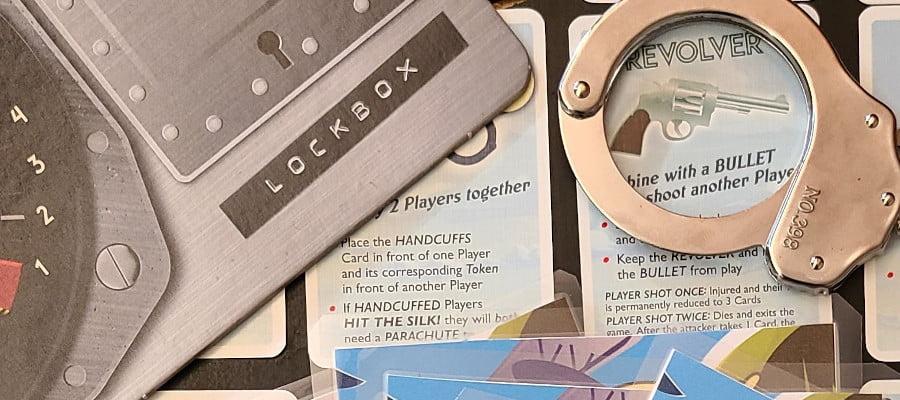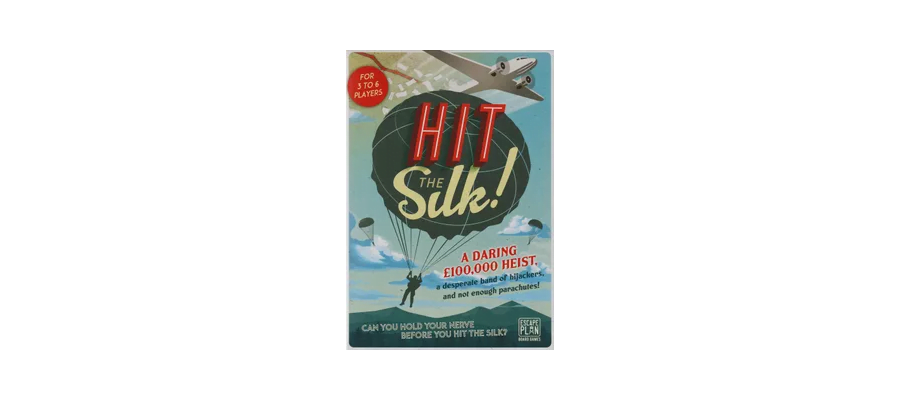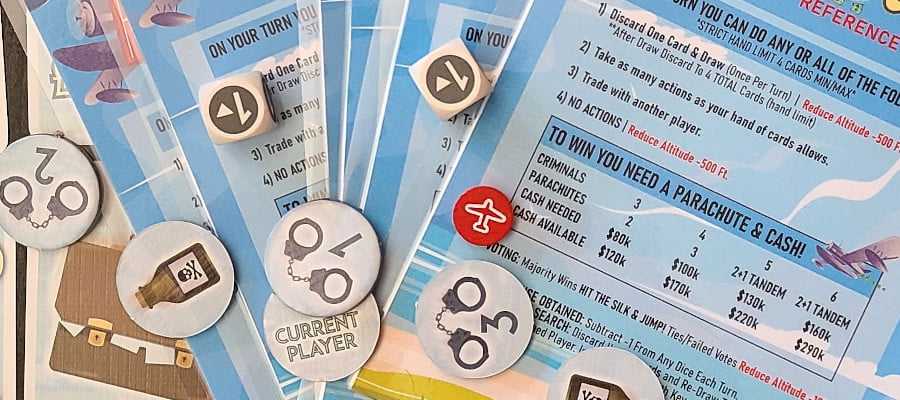I like Hit The Silk. If you’re not familiar with Hit The Silk and also to extend the introduction a little bit, it’s a card game where the players are a bunch of crooks on a plane at the last part of a heist movie that has gone completely terrible. The characters of Hit The Silk are all riding a plane without a pilot, with a pile of money to divvy up, and there’s always not enough parachutes. You have two competing demands, then, as a player, one of which is a numeric value (how much money you get, and if you can get over a threshold), and one of which is a binary value (did you get out with a parachute or are you dead).
The plane is going down, and it goes down faster and faster as you go on – so there’s a clock on how many turns players can play and two competing failure states. Oh one of the other competing failure states is that you can kill people and lock them to one another with handcuffs but they can get out of handcuffs with keys but then those keys can’t be used to raid the plane’s lockbox and potentially get more money. You can attack people to take cards off them, and that means that now, you don’t want people to know too much about what’s in your hand, but your only way to get cards into your hand tends to be interacting with people in trades.
The result is a game that’s vicious and mean and tense and a delight. I like it a lot. Particularly, I like it as a game that’s doing a lot to make players lie.
Some games, like Secret Hitler, have rules in them to stop players expressing true information at points in the game. A lot of games, like Bridge, have rules about what players aren’t allowed to talk about. Hit The Silk doesn’t tell you any such thing – you can tell anyone what you want about what’s in your hand (though you can’t prove it necessarily). I think this betrays a confidence – the game doesn’t tell you that you can’t talk about things, and instead just gives you incentives to not talk about things. You can make yourself a target if you’re too convincing about what you’ve got, and every turn the game progresses, the game gets closer to its end, meaning that as the opportunities to get knifed represent more use of the remaining time, you might get more and more ‘honest’ about what’s in your hand. The situation gets stressful so you act like it’s stressful which means even if you’re a bad liar, everyone looks like a bad liar at that stage.
Hidden agenda games, like Werewolf and Unfathomable want some players to lie, while also making it hard if not impossible for players to be convincing about their own information. What’s more, those hidden agenda games are often built around surviving multiple rounds of discussion. This particular kind of pressure is difficult for a whole category of player to handle: Some players, even players who are interested in playing these games, can crack up under the long, slow boil of that kind of game. And that can be a potent thing for some players, too! That’s not bad.
But it’s not how Hit The Silk works.

The thing I like about Hit The Silk in this context is that the game’s fiction and its gameplay engine puts you under pressure. It’s not the slow cold formless tittering pressure of Werewolf. It’s not the vibe that you have a long big task ahead of you and you can just get bits of it done and then the traitor thing will work itself out to distract you. In the first turn of Hit the Silk you know what you need and you know that you’re not going to get it on your own, even if you already have it; if you somehow start with debt money and a parachute, great, now you have to keep it and you have to play cards so nobody looks at you like you’re absolutely, obviously, the most blatantly hittable pinata around.
The fiction is important here to the operation of the cards. Cards depict momentary actions, action sequence moments, revealing you know kung fu or waving a knife or robbing someone or handcuffing them to something. There’s no long-term plan (because there couldn’t be), there’s no ‘draw a lot of cards and gas up’ or ‘get a lot of options and contemplate them’ in the design. Your hand size can even shrink when you’re wounded, meaning that when you get wounded, you’re now under even more pressure to do more with less, and now you’ve got a reason to be reckless, to take big swings if you can. The game’s design chooses to make the fiction of the card’s representation immediate and abrupt.
Then it clogs up the deck with cards you want to have but don’t want to use.
It’s a well-balanced machine there. You need money, you need a parachute, so basically two of your cards are occupied, maybe even three if your money units are small. But you need to play an action and you want to protect yourself, so you can’t use a knife and have an antidote in case you get poisoned – oh yeah there’s poison as well, and that poison kicks in at a fixed point in the game.
What it means is that Hit the Silk is a game about lying but it puts the incentive to lie behind two layers of additional pressures; you don’t have enough and you can’t prove enough and you don’t have much time. Rather than the slow boil of all these other games, with creeping, clinging failures bringing you closer and closer to the end of the game, Hit The Silk can be reconfigured in the last minute to make you the winner or the loser, and you just need to rely on being trusted enough but not too much on the way there.
I do wish it was a little quicker, a little slimmer – no need for a board, make it a pure card game – but that’s just my aesthetics as a designer, wanting minimal components if I can. And you know, materiality is a thing unto itself.
I don’t have, and haven’t played Hit The Silk. It’s something I like to watch, instead. It’s a game that sits at arm’s length to me, a thing where I want to watch all the pieces moving around without me being directly invested.

